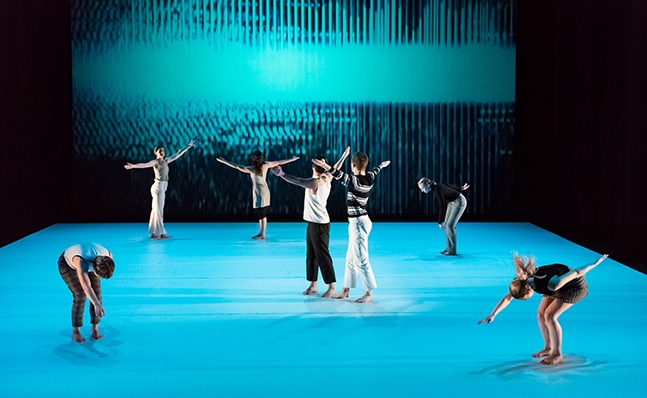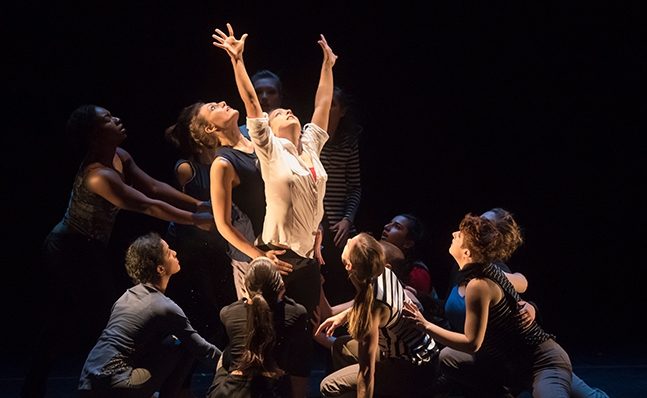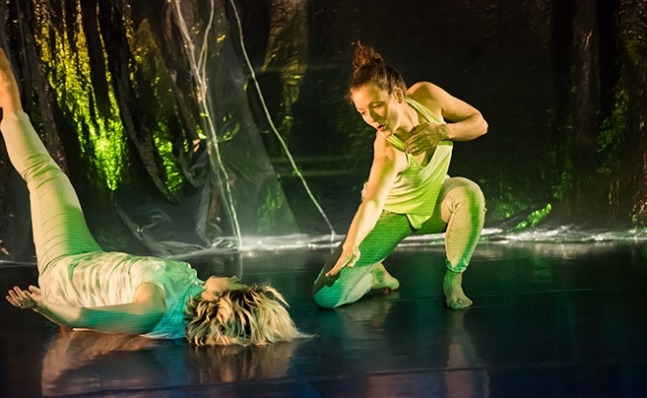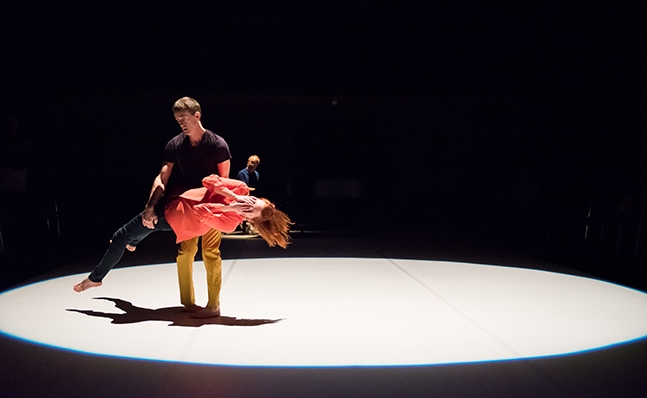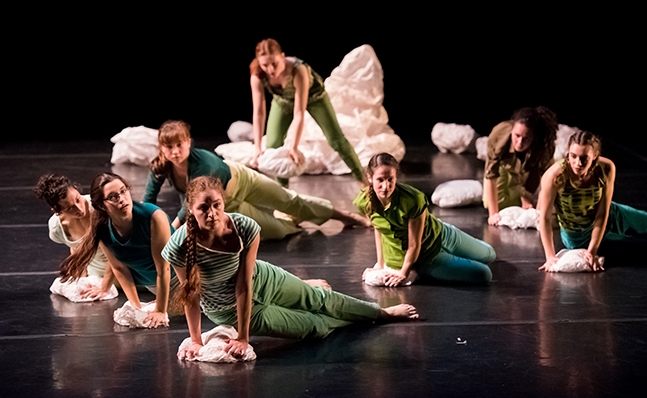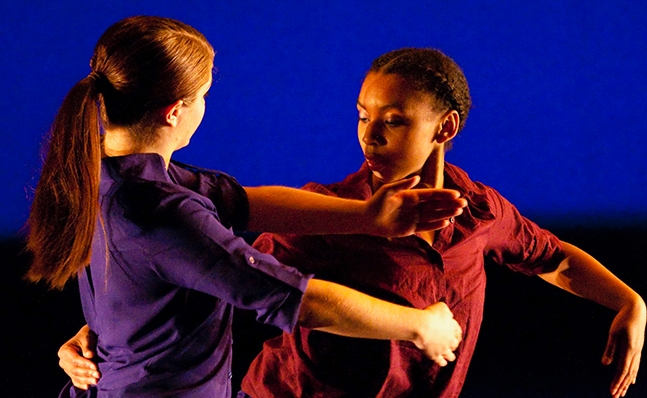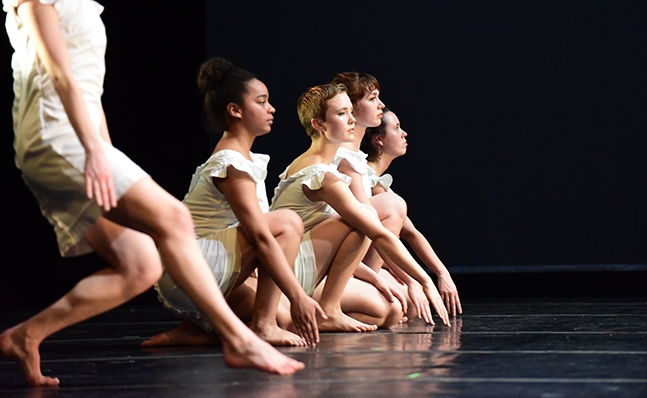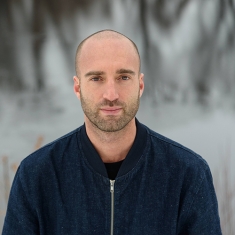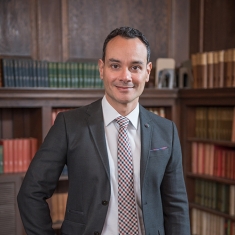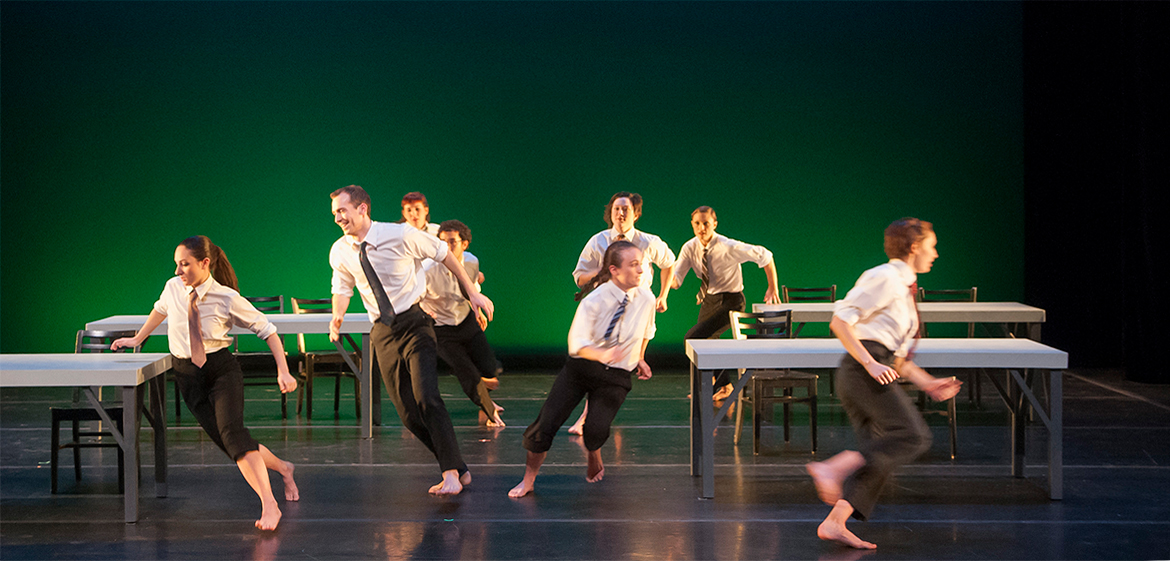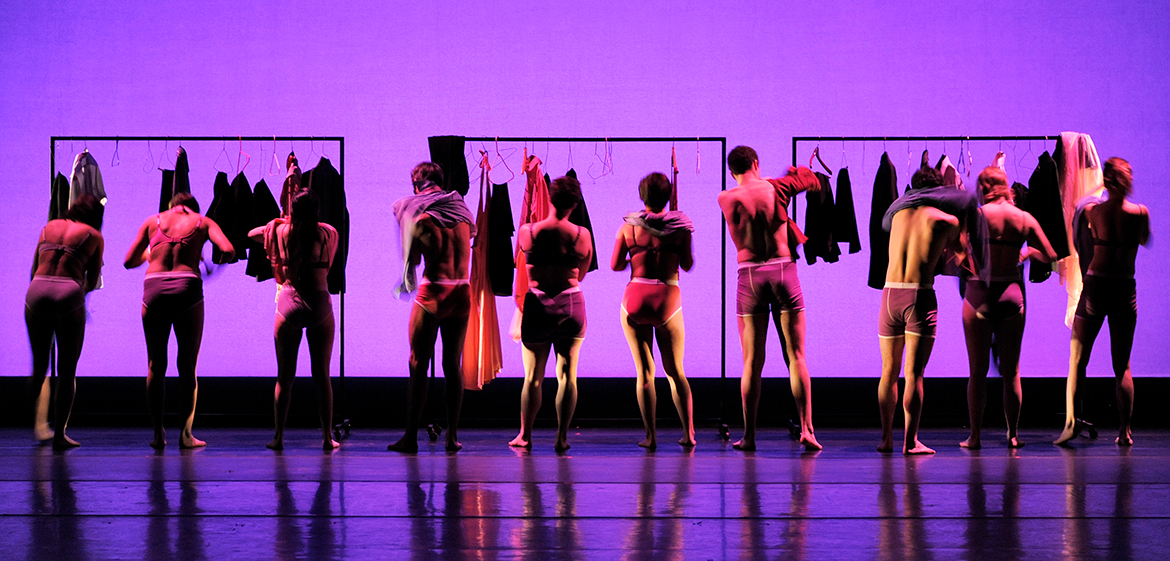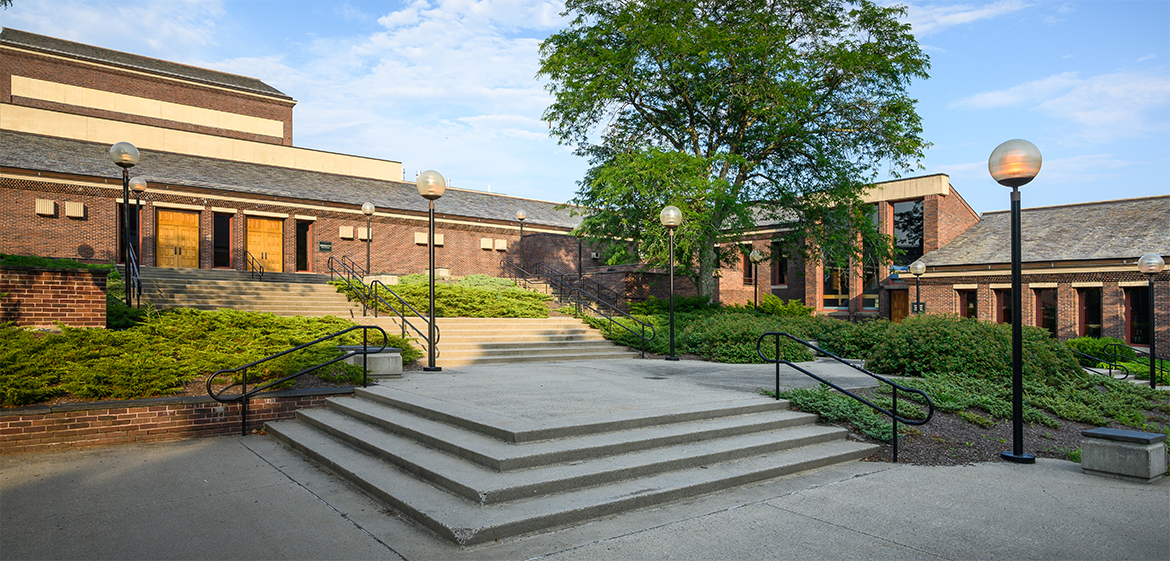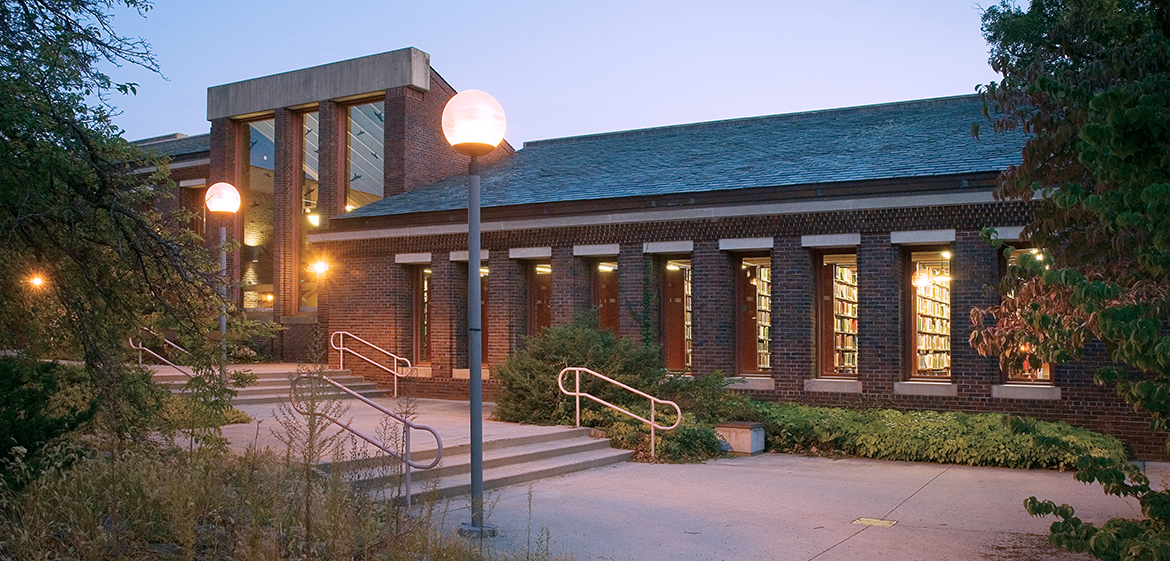Dance

The Smith College Department of Dance gives students a broad view of dance in preparation for professional performance careers, as a training ground for choreographers, or to prepare for study in graduate dance programs. Students who do not intend to pursue dance professionally are also welcome.
In both the undergraduate and graduate programs, the faculty is dedicated to fostering each student’s unique talents as the student explores creative dance experiences. The Smith dance department is a member of the Five College Dance, a nationally recognized model for excellence in dance in higher education.
Announcements
Check Your Email Daily
Smith dancers, please check your email daily. You will receive updates directly from your course instructors regarding your practice-based dance classes as well as your theory-based courses.
Five College Dance Auditions
Stay tuned to the Five College Dance announcements page for the Five College Dance placement and audition events in the Fall 2023.
Fall 2023 Dance Course Offerings
Are you looking for a dance course to add in the fall? Check the course search for Dance which contains classes, instructors, times and locations for the courses we offer in the spring. Send any questions to dance@smith.edu.
Smith's dance courses include contemporary modern, ballet, jazz, West African, dance history, dance composition, cultural studies, anatomy-kinesiology and advanced seminars in special topics. Most technique classes are taught with live music.
There is no mandatory core curriculum at Smith, and interdisciplinary studies are encouraged. Senior dance majors complete a thesis course and a choreographic or research project. Students are encouraged to study and perform at other schools in the Five College Dance Department; a fare-free bus system connects the campuses.
The dance department at Smith works out of four studios, two dedicated theaters and one informal theater. The Josten Library for the Performing Arts maintains an outstanding dance collection. There is a fully staffed costume and scene shop in the performing arts center.
There are four full-time faculty and a staff musician, eight graduate teaching fellows and several professional adjuncts and part-time musicians. The department sponsors regular master classes and special workshops, often led by members of such national touring dance companies as Mark Morris, Trisha Brown and Company and Urban Bush Women. Recent visitors have included guests from Ballet Theatre du Bourdeau, the Alvin Ailey Dance Company, the Royal Winnipeg Ballet and the Bill T. Jones/Arnie Zane Company. Master classes and workshops are often given by artists who are performing at the Fine Arts Center at the University of Massachusetts Amherst. A student-run dance company, Celebrations, was founded in 1983.
Five College Dance combines the programs of Amherst, Hampshire, Mount Holyoke and Smith colleges and the University of Massachusetts Amherst. The faculty operates as a consortium, coordinating curricula, performances and services.
The department, formed for the mutual benefit of all member institutions, supports a variety of philosophical approaches to dance and provides students an opportunity to experience a wide spectrum of performance styles and techniques. The faculty operates as one department, unifying its educational mission to include a well-balanced curriculum emphasizing a broad integration of technical, creative, historical and analytical aspects of dance; a wide variety of philosophical approaches to teaching; diverse course offerings enabling students to experience numerous performance styles, techniques and theoretical perspectives; and shared resources that provide a rich artistic and scholarly environment.
The collaborative structure of the department provides a large and diverse community of colleagues with whom to share pedagogic as well as artistic perspectives. Students may take a dance course on any of the five campuses and receive credit at their home institution, and course offerings are coordinated among the campuses to facilitate registration, interchange and student travel. Five College Dance is a nationally recognized model for excellence in dance in higher education.
The major is designed to instill a broad view of dance in preparation for a professional career or further study while promoting liberal arts learning capacities. Students complete courses in dance history; anthropology and aesthetics; composition and creative process; kinesiological and somatic aspects of dance; dance production; and dance technique, movement vocabulary and performance. A dancer’s instrument is her body and it must be trained consistently; technique courses are therefore a core component of the curriculum.
The capacities for the major in dance overlap and are integrated throughout the curriculum. In this section we individuate these capacities into subsets of the discipline.
Dance Technique. By graduation, dance majors have engaged deeply with the physical practice of dance and possess the embodied knowledge and physical training that enables them to perform and generate a variety of technical dance skills. These courses focus on the practice and analysis of movement. They promote the development of physical skills and physical intelligence (the ability to efficiently solve movement and performance-related tasks/problems). Students generate and analyze physical data through courses in technique and improvisation movement. Their understanding of expressive human movement is the bedrock of their studies and interwoven in all creative and theoretical research in dance.
Composition and Creative Process. Creative research through choreography and dance repertory comprises a large part of the theory requirements for the major. This sequence of courses begins with the most basic study of dance composition—gesture, space, time, energy—and focuses on tools for finding and developing movement. The second- and third-level courses develop the fundamentals of formal choreography and expand work in the manipulation of spatial design, dynamics, phrasing, rhythm, content and music. The movement materials that a student explores are not limited to any specific genre. This sequence also includes 4-credit repertory courses at the intermediate and advanced levels, in which students, as dancers, are participants in the creative process and development of faculty and guest artists’ choreography.
Dance History, Anthropology and Aesthetics. Further study of dance is divided into dance aesthetics, dance anthropology and dance history. Students learn to conceptualize dance through these theoretical lenses and apply methods in dance history, anthropology and aesthetics in their own research. They also acquire an interdisciplinary understanding of dance scholarship through study of dance theory in dialogue with fields such as area studies, gender studies, African American studies and film studies. The theory curriculum promotes dance literacy through a broad perspective that highlights the practice of this art both in the United States and globally, as a concert form and also an expression of popular culture, in variety of social contexts and serving a vast array of artistic and cultural purposes.
Dance Science and Somatics. The science of movement, perception and intention underlie all aspects of dancing. Dance majors acquire skill in these areas through mindful, directed practice, feedback from their instructors, and from learning about anatomy, physiology, motor control and learning and the study of somatics. Although this material is covered specifically in the scientific foundations of dance, it is integrated into our technique courses as well. Emphasis is placed not only on functional alignment, coordination and the development of basic and higher level physical skills, it is also on the cognitive and emotional processes that clarify intention, expression, performance awareness, creative imagination and perceptual attunement both to one’s surroundings and one’s body.
By learning the science and somatic principles of dance, students are able to analyze movement and movement pedagogy, critically assessing how what they are doing can be deepened through the knowledge of the mind/body and how what they are doing might either be expanding their movement potential or potentially causing harm to their body. Dancers learn to critically assess the concept of body image, posture and fitness. They learn that movement intelligence is not about a body type or movement that looks a certain way, but the capacity to engage in the task of solving movement and performance problems or challenges. It is about the development of resilience and the ability to draw upon varied experiences to have an increased potential to adapt to emerging situations.
Music and Dance. The study of music for dance is the topic of a full theoretical course required for the major but also an important discussion in all choreography and repertory courses. Finding and accurately naming music-specific information as related to dance, particularly with respect to rhythm and phrasing, is an expected skill of all majors. Additionally they learn to recognize aspects of basic music theory and the cultural, cognitive and emotional effects of listening. Majors also grow an ethical and respectful approach to live and prerecorded music as the artistic expression and intellectual property of composers, accompanists and performers.
Advisers: Rodger Blum, Lester Tomé, Chris Aiken, Angie Hauser
The dance major at Smith is offered through the Five College Dance Department and culminates in a bachelor of arts degree from Smith College. It is designed to give students a broad view of dance in preparation for a professional career or further study. Students are exposed to courses in dance history and culture, creative and aesthetic studies, scientific aspects of dance, the language of movement, and dance technique and performance. A dancer's instrument is her body and it must be trained consistently: at least five dance technique courses are required for the B.A. (ten are allowed for credit toward the GPA). Students should reach intermediate or advanced level in at least one form. A single level of technique courses may be taken for credit up to three semesters. Advanced technique courses (Levels V and VI) require a placement exam.
A minimum of 48 credit hours are required for the major.
Dance Research Skills and Materials (Smith College Libraries)
History
Dance History: Political Bodies from the Stage to the Page (DAN 171) and Dance Anthropology: Performed Identities and Embodied Cultures (DAN 272) serve as the introduction to the major. At the advanced level there is Advanced Studies in History and Aesthetics (DAN 377) with rotating topics. These courses all examine the dance itself and its cultural context.
Creative and Aesthetic Studies
(DAN 151, 252, 353, 209 and 309) This sequence of courses begins with the most basic study of dance composition: space, time and energy, and focuses on tools for finding and developing movement. The second- and third-level courses develop the fundamentals of formal choreography and expand work in the manipulation of spatial design, dynamics, phrasing, rhythm, content and accompaniment. The movement materials that a student explores are not limited to any particular style. This sequence also includes four-credit repertory courses at the intermediate and advanced level.
Scientific Aspects of Dance
(DAN 241, 342) These courses are designed to develop the student's personal working process and her philosophy of movement. The student studies selected aspects of human anatomy, physiology, biomechanics and their relationships to various theories of technical study.
Language of Movement
(DAN 285) Courses in this area train students to observe, experience and notate qualitative aspects of movement (Laban Movement Analysis) and to quantitatively perceive and record movement (Labanotation).
Music for Dancers
(DAN 287) Sharpens understanding of music fundamentals and makes these applicable to dance.
Major Course of Study
Students in the Bachelor of Arts in Contemporary Dance program are urged to pursue a breadth of study in technique courses, and, in consultation with their adviser, make connections to other arts departments.
Requirements
Theory (must take each of the following):
- 151, Elementary Dance Composition
- 171, Dance History: Political Bodies from the Stage to the Page
- 241, Scientific Foundations of Dance
- 272, Dance Anthropology: Performed Identities and Embodied Cultures
- 287, Analysis of Music from a Dancer's Perspective
- 200, Dance Production
- 201, Dance Production
- 252, Intermediate Dance Composition
Five dance technique courses are required for the B.A. (Up to 10 are allowed for credit toward the GPA.) B.A. students must explore at least two courses in two technique forms for credit. Students should reach intermediate or advanced level in at least one form. A single level of technique courses may be taken for credit up to three semesters. Advanced technique courses (Levels V and VI) require a placement exam.
Advanced Theory (Choose at least two)
- 305, Advanced Repertory (taken twice)
- 309, Advanced Repertory
- 339, Movement, Ecology and Performance
- 353, Advanced Dance Composition
- 377, Advanced Studies in History and Aesthetics
- 400, Special Studies (Choreography or Research)
A thesis project is required in the student's senior year in choreography or research. If offered, students will take the seminar course. Otherwise, an independent project with an adviser will be designed. Students are encouraged to speak with their major adviser about an honors thesis. This conversation should begin at the end of the junior year.
Senior Thesis
399 Senior Seminar in Dance (Choreography or Research)
Honors
430d/431 Honors Project, 8 credits
Please consult Angie Hauser, director of honors in dance, and the class deans' website for specific requirements and application procedures in the spring semester of your junior year.
First Year
- Dance History: Political Bodies from the Stage to the Page
- Elementary Dance Composition
- DAN 200
- Three technique courses for the year
Second Year
- Scientific Foundations of Dance
- Intermediate Dance Composition
- Dance Anthropology: Performed Identities and Embodied Cultures or
Analysis of Music from a Dancer's Perspective (both are required) - DAN 200
- Three technique courses for the year
Third Year
- Dance Anthropology: Performed Identities and Embodied Cultures or
Analysis of Music from a Dancer's Perspective (both are required) - DAN 377/Advanced Theory (including Advanced Repertory)
- Two three-technique courses for the year
Fourth Year
- DAN 377/Advanced Theory (including Advanced Repertory)
- Senior Seminar in Dance (or Honors Thesis)
- Two three-technique courses for the year
This plan is a suggested course of study. Many classes may be taken in any year based on students’ schedules, class availability and prerequisite requirements.
It is extremely common for students to major in dance while pursing a second major in another field. Students who wish to consider this option should meet with a faculty member in dance in their first year.
Dance majors who are considering study abroad in their third year should realize that academic dance theory classes do not exist in some countries and plan their major carefully during their time at Smith—with the assistance of a faculty adviser.
It is possible to double major and study abroad, but students must plan carefully to do so. Students who wish to consider this option should begin to complete theory requirements for the dance major in their first year with the guidance of a dance faculty member.
Advisers: Rodger Blum, Lester Tomé, Chris Aiken, Angie Hauser
The dance minor is composed of core courses that provide experience in primary dance theory and technique. Additional theoretical courses should be chosen after discussion with the dance faculty adviser.
A minimum of 27 credit hours are required for the minor.
Dance Research Skills and Materials (Smith College Libraries)
Required Courses
- 151, Elementary Dance Composition
- 171, Dance History: Political Bodies from the Stage to the Page
- 272, Dance Anthropology: Performed Identities and Embodied Cultures
- 241, Scientific Foundations of Dance
- 287, Analysis of Music from a Dancer's Perspective
- 200, Dance Production
- 113-335, Dance Technique: at least three two-credit technique courses
Dance in Performance
Opportunities are plentiful for students—whether majors, non-majors or graduate students—to perform or present their own choreography, either through concerts at Smith or performance opportunities at the other four colleges.
Emeriti
Susan Kay Waltner
Professor Emerita of Dance (2011)
Yvonne Daniel
Professor Emerita of Dance and Afro-American Studies (2004)
Lecturers &
Guest Artists
Ellie Goudie-Averill
Olive Demar
Laura Grandi
Danny Guzman
Duane Lee Holland Jr
Alpha Bisco Kaba
Sarah Konner
Teaching Fellows
Francesca Baron
Caitlin Canty
Gabriella Charmichael
Laura David
Niki Farahani
Yun Lee
Gabrielle Revlock
Madelyn Sher
Additional Department
Members
Olive Mckeon
Research Associate
Balinda Craig-Quijada
Research Associate
Dance Administrative Staff
Martha Potyrala
Administrative Assistant
Smith College Dance Production
Shelley Latham
Publicity Manager
Nikki Beck
Publicity and Production Assistant
Emily Justice Dunn
Dance Costume Designer
Tilly Adams
Assistant Costume Shop Director
Amy Putnam
Technical Director
Cel Humphries
Assistant Technical Director
David Wiggall
Lighting and Sound Supervisor
Five College Dance Production
Matthew Adelson
Five College Dance Department Production Manager
Hayden Gadd
Five College Dance Technical Director
Carlie Nieman
Five College Dance Department Assistant Production Manager
Master of Fine Arts in Dance
The Master of Fine Arts in Dance is designed for students who prefer to work in an intimate environment with a small group of peers in order to maximize the growth and development of their interests and potential.


